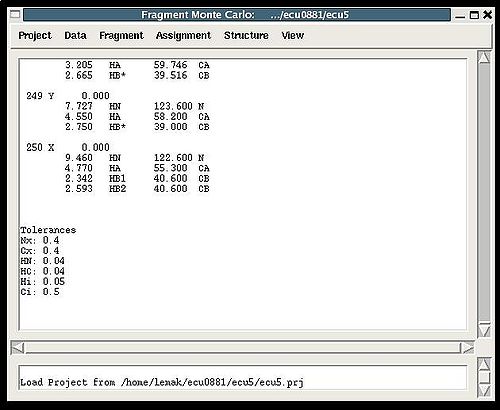Resonance Assignment/Abacus/FMCGUI objects
- protein sequence
- peak list
- PB fragments
Protein sequence
Peak list
- (+) peak list needs to be referenced
- (+/-) peak lists could be referenced, but it isn't necessary
- (-) peak lists could be referenced, but it won't be used by FMCGUI
N15 NOESY
|
-
|
C13 NOESY H2O
|
-
|
Arom NOESY
|
-
|
N15 HSQC
|
+
|
C13 HSQC
|
+
|
HNCA
|
+/-
|
HNCO
|
-
|
CBCACONH
|
+/-
|
HBHACONH
|
+
|
List of PB fragments
User ID
Fragment ID assigned by user, U_id. U_id can’t be changed within FMCGUI.
Assignment ID
Assignment ID, A_id, indicates the sequence position ID to which the fragment is assigned.
A_id = -99 if the fragment is not assigned to any position in the sequence.
A_id could be set up or modified by the following commands {Assignment>Fix Assignment>Manually}, {Assignment>Fix Assignment>Using probability Map}, and {Assignment>Fix Assignment>Reset all }.
Typing probabilities
Tt (f) is a probability for fragment f to have amino acid type t. Here t corresponds to one of 20 amino acid residue types, and f is fragment user ID.
Typing probbilities can be calculated or modified manually by the commands {Fragment>Type>Calculate} and {Fragment>Type>Fix}, respectively.
Contact map
- There are three fragment contact maps: Cf1HNCA(f2) , Cf1NOE_B(f2) , and Cf1NOE_F(f2) , respectively. Each contact map scores the possibility for any fragment f1 to be next to the fragment f2 in protein sequence. Here f1 and f2 stand for fragment's user ID.
Assignment probabilities
Ps(f) is a probability of fragment f to be assigned to sequense position s, where f is fragment user ID, and s is sequence position ID. There are two assignment probabilities associated with a fragment - PsSA(f) and PsREM(f) - that are calculated using Simulates Annealing (SA) and Replica Exchange Method (REM) Monte Carlo simulations, respistively.
Main window
Figure 2.1
- the title bar displays the name of the current project and the directory inside which the project is located;
- the bar with six menus: Project, Data, Fragment, Assignment, Structure, and View, respectively;
- the project main window, where all messages from the last executed command are displayed ;
- the log window, where the history of executed commands is shown.
